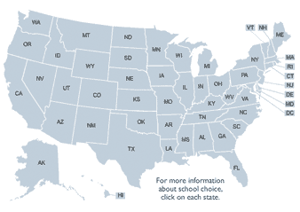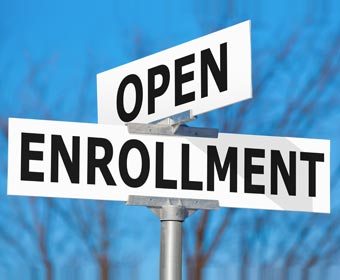I don’t know what the open enrollment scene is like in or around your district, but I saw a news clip on the open enrollment/school choice issue that illustrates the importance of communications around this topic. One large urban school district recently decided to implement an online lottery plan to determine which students can get the opportunity to apply to the district’s magnet schools. They had been using a “first-come, first-served campout” process for years.
Some parents and community members are up in arms because they were blindsided by the new policy. Aside from the very important issue of open enrollment and precious dollars that surround it, this story and others are less one of school policy, but more a communications issue.
School choice creates opportunities and challenges
 Many folks are working hard to improve educational opportunities for school children. School choice aims to provide families with more options, regardless of location, socio-economic status, or special needs. Supporters and opponents alike, however, have realized unintended consequences, both positive and negative.
Many folks are working hard to improve educational opportunities for school children. School choice aims to provide families with more options, regardless of location, socio-economic status, or special needs. Supporters and opponents alike, however, have realized unintended consequences, both positive and negative.
The open enrollment movement has resulted in windfalls for some districts and horrific fallouts for others. For those districts where referendums factor in, local levies, bond issues and other school elections are now more complex than ever. For those states where funding is less localized, debates still rage in the political machine. Many decision makers and voters are asking themselves and their neighbors questions like:
- “Do I vote for our local school levy, if my child attends a different district?”
- “Should I approve more classrooms to attract out-of-district students?”
- “Will out-of-district students raise or lower our state-issued report card?”
- “How will this election affect property values and rent?”
Communities are voicing their opinions for outcomes that favor their specific circumstances. School administrators are looking to gain a favorable end. Open enrollment schools have three basic paths to pursue: shrink, maintain or increase enrollment levels.
School funding is at the heart of open enrollment
 A majority of states now have school choice policies. Those come in a multitude of variations. Each state serves as a laboratory of ideas. All are hitched to public education dollars. Most plans tie pre-established amounts to an individual student.
A majority of states now have school choice policies. Those come in a multitude of variations. Each state serves as a laboratory of ideas. All are hitched to public education dollars. Most plans tie pre-established amounts to an individual student.
Typically the money goes to the public school the student chooses to attend. Some states offer tax credits, others offer vouchers, and sometimes these go to non-public schools and any school (e.g., home schools) that meet state standards.
Billions of tax dollars are at stake in this new shuffle of educational revenue. It should come as no surprise that many schools are opting to chase the money. They are vigorously vying for students linked to those dollars. There are also those overcrowded schools content to see teacher student ratios improve as families opt out of their home districts. Then there are schools who are content to await the winds of change.
Communications: school choice’s best ally
The challenge of luring eligible students to pad their school budgets, or in some cases, put a halt to enrollment slides, red ink, or school closures (see related story), transcends open enrollment and gets to the issue of school communications.
Whatever the goals of a school district are, it becomes a matter of communications – promoting and marketing a stance, striking partnerships, or simply announcing achievements and telling your school stories. Districts spend a lot on communications: staff and budgets, IT infrastructure, websites, mobile devices, consultants and more. So start telling your story.
As for the “online lottery vs. campout” case, one piece of advice I can give districts is to avoid such public backlash on this and any potentially sensitive issue. Prepare a communications strategy to engage parents early in the process, in the evaluation and planning for such changes.
Additionally, as a firm believer in the power of web communications to help schools enunciate their own stance on topics like open enrollment, I offer these web communications pointers...
1. Build a team of modern-day school communicators
School boards have developed keen interest in attracting administrative personnel with communication skills. Many are expanding their hiring criteria. They seek those with marketing and technology skills: people who know how to use modern tools to communicate.
Beyond your own staff, a small team of volunteers or even a single person can help influence the outcome. Every district has a group of ardent, talented supporters. Learn to leverage them. Many staff and/or community members are willing to accept stipends to help. Districts with financial challenges can often get help by simply asking. Getting asked to help is honor enough for some to volunteer their services. Remember, leadership doesn't mean you have to do everything yourself.
2. Use the right web communications methods
Today's media channels are the most effective and (thankfully) cost efficient methods to inform and guide public sentiment. People are looking less toward traditional information formats like newspapers, public meetings, etc. Rather, websites and social media outlets like Facebook, Twitter, Instagram, YouTube, etc. are their go-to sources. The good news is that schools rule their own content in these areas.
Each district has a unique story to tell. Do this by putting a spotlight on your positives. Showcase your staff and highlight student achievements. Turn simple programs into events. It's time to get creative!
Ensuring that your website is the central hub of communication is key. Everything else you do to promote your position, should always include your website's URL. In real estate, the mantra is: location, location, location. Your website mantra should be: update regularly, regularly, regularly.
3. Find a web communications partner everyone will appreciate
Swallowing this communication elephant can seem overwhelming. Relax and take it a forkful at a time. Get started by creating or getting a website plan and work it, really work it.
Find a supportive web hosting partner with a focus on educators. Use one with a mix of tools that match up well with your unique set of resources and needs. This is no time for learning how to build websites. Find a solution that lets you concentrate instead on messaging, not coding.
Resist those with endless lists of bells and whistles that are fun for techies but seldom used. Speaking of techies, you shouldn’t have to be the only one to contribute to your school’s website. Remember, updating regularly is the daily grind, and it must be easy for everyone.
4. Start now, because you know your neighboring district has
You haven’t started yet? Families are discussing school choices with every paper and report card brought home. Ask yourself the tough questions:
- How many budding academics, musicians and athletes are you willing to lose?
- Am I prepared to see the district’s category averages go down?
- How much will our budget shrink?
- What else happens if dozens or hundreds move on?
It’s high time your community (and the surrounding communities) know what your position is. Whether the topic is a new open enrollment application process or your principal’s take on the homecoming theme, make your stakeholders aware of every facet that your school does well, especially those that tend to be uncommon. Show them reasons to be proud. Your competing districts will be happy if you don’t.
Topics: Marketing Communication School Districts

About the author
As co-founder of SchoolNow, Steve believes behind every great school is great communication. He's on a mission to continue to simplify communications for school administrators and help them boost engagement with parents and the entire school community.
.png?width=64&height=63&name=Group%20(4).png)
.png?width=66&height=64&name=Group%20(5).png)
.png?width=56&height=60&name=Group%20(6).png)
.png?width=66&height=52&name=Group%20(7).png)
.png?width=56&height=56&name=Group%20(9).png)
.png?width=59&height=52&name=Group%20(10).png)


